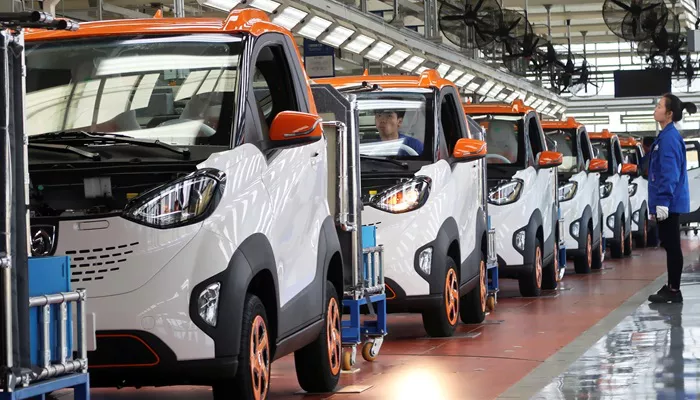Before Chinese electric vehicles (EVs) became a common sight on the busy streets of Dushanbe, Tajikistan’s capital, Tolib Raufov, a local taxi driver, recognized the potential of these cars. Three years ago, he bought his first Chinese EV for around $30,000. Last year, he resold it for a significant profit and used the money to buy a newer model from BYD, China’s leading EV manufacturer, for just $21,000. This move, he says, has improved his profit margins, thanks to the car’s affordability, strong resale value, and the money saved from no longer needing to buy gasoline.
“I have no regrets after buying a Chinese electric car,” Raufov told RFE/RL. “It’s never been this profitable for me to drive a taxi in Dushanbe.”
Raufov’s experience highlights a broader trend in Central Asia, where Chinese influence is reshaping the economy and transportation landscape. Central Asian governments are facilitating the adoption of Chinese-made vehicles with tax breaks, infrastructure investments, and new local factories. Analysts believe this shift not only transforms the region’s transport system but also deepens the economic and political ties between Central Asia and China.
The rise of Chinese EVs in Central Asia contrasts with Western efforts to curb imports. The U.S. and EU have imposed tariffs on Chinese electric cars in recent years, a stance likely to intensify amid growing trade tensions. These tariffs could drive more Chinese manufacturers to expand production in the region, potentially diminishing competition from Western firms.
Yunis Sharifli, a fellow at the China Global South Project, said, “The Trump administration’s tariffs are likely to further stimulate China’s EV exports to Central Asia and may push Beijing to expand local production in the region.”
China’s Growing Dominance in Central Asia
China’s dominance in the Central Asian car market is the result of a long-term strategy. Temur Umarov, a fellow at the Carnegie Russia Eurasia Center, explained that the region’s demand for affordable, high-quality vehicles has driven China’s growth in the EV sector.
A key element in China’s strategy has been the Belt and Road Initiative (BRI), a massive infrastructure plan aimed at securing new trade routes and improving access to Central Asia’s valuable resources. Over the past decade, China has become a leading trade partner and foreign investor in the region. As a result, Chinese companies are playing a larger role in Central Asia’s economic development.
Tajikistan has introduced several measures to promote EVs, including tax incentives and a decade-long exemption for EV imports. The government is also expanding charging stations across the country. In Dushanbe, the mayor recently passed legislation to transition the city’s taxis to electric vehicles. The government has set a target of having 30 percent of the country’s cars be fully electric by 2030.
Rustam, a car importer in Dushanbe, said that the shift toward Chinese vehicles was accelerated by the COVID-19 pandemic and Russia’s war in Ukraine. In the past, he imported cars from Europe, but disruptions to supply chains and the growing affordability of Chinese cars made importing from China more attractive.
“The Chinese produce high-quality cars now,” Rustam said. “Even if sanctions are lifted, the situation in our market will not change.”
Central Asia’s Rapid EV Expansion
Central Asia is becoming both a key market and a production hub for Chinese electric vehicles. While Turkmenistan, the region’s most isolated country, is slower to adopt EVs, other countries are seeing rapid growth in Chinese car imports.
In Kazakhstan, the sale of Chinese EVs soared by 36 times in 2024, reflecting the country’s growing demand for electric vehicles. The Kazakh government is also working with Chinese companies to develop local production. A new plant will soon begin assembling Chinese models from companies like Chery, Haval, and Changan.
Kazakh industry expert Oksana Chernonozhkina noted that Chinese brands have quickly gained market share in Kazakhstan, outpacing European and U.S. competitors. “It’s been a lightning pace of development,” she said, pointing to Chinese firms’ investments in top designers and engineers.
In Uzbekistan, President Shavkat Mirziyoyev attended the opening of a BYD factory in Jizzakh in 2024. The plant is set to create thousands of jobs and ramp up production from 50,000 vehicles annually to 500,000. Uzbekistan has also made it easier for local entrepreneurs to build charging stations, further boosting the EV market.
As a result of these policies, EV sales in Uzbekistan have grown rapidly. In 2024, for the first time, the country imported more EVs and hybrids than traditional gasoline-powered cars. Local driver Kahramon, who recently switched to an electric BYD e2, said his savings have been substantial, with his monthly fuel costs dropping from $300 to just $10.
Kyrgyzstan as a Reexport Hub
Kyrgyzstan has emerged as a major reexporter of Chinese vehicles, especially EVs, to Russia. In 2023, Kyrgyzstan imported $651 million worth of Chinese hybrid cars and, in 2024, brought in over $200 million worth of EVs. While many of these vehicles are intended for the Russian market, Chinese cars are becoming more common on Kyrgyzstan’s roads.
Daniyar Salyakaev, a car importer in Kyrgyzstan, explained that local entrepreneurs capitalized on the opportunity created by Western sanctions on Russia. With Kyrgyzstan’s liberal customs procedures and geographic proximity to both Russia and China, businesspeople have been able to resell cars across borders.
While the reexport market has slowed due to changing Russian customs rules, the infrastructure and relationships built during this time will likely support Kyrgyzstan’s growing local demand for Chinese vehicles.
“While Kyrgyzstan was becoming a hub for reexporting cars to Russia, a certain infrastructure was built here with professional networks and services to import cars from China,” Salyakaev said. “That looks set to stay.”
As Chinese EVs continue to expand across Central Asia, they are reshaping the region’s transportation landscape and strengthening ties between Central Asia and China. With government incentives and rising demand, this shift is set to continue, potentially making Central Asia a key player in the global EV market.

